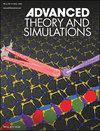Effect of Atomic Charges on C2H2/CO2/CH4 Separation Performances of Covalent-Organic Framework Adsorbents
IF 2.9
4区 工程技术
Q1 MULTIDISCIPLINARY SCIENCES
引用次数: 0
Abstract
A critical factor for the accuracy of computational screening studies is the method employed to assign atomic charges. While chemically meaningful atomic charges can be obtained using a quantum chemistry method-based charge assignment technique (density-derived electrostatic and chemical method (DDEC6)), its application to large material datasets remains computationally demanding. As an alternative, machine-learning (ML) models can offer the ability to determine atomic charges with high accuracy and speed. Herein, two ML models, Partial Atomic Charge Predicter for Porous Materials based on Graph Convolutional Neural Network (PACMAN) and Partial Atomic Charges in Metal-Organic Frameworks (PACMOF), are utilized to predict atomic charges in Clean, Uniform, Refined with Automatic Tracking from Experimental Database (CURATED) covalent-organic frameworks (COFs). The predicted atomic charges are used in simulations to assess COFs' C2H2/CO2/CH4 separation performances in comparison with reference DDEC6-based performances. Results show PACMAN charges can more effectively reproduce DDEC6-based charges and corresponding separation performance metrics, underscoring their suitability for high-throughput material screening. Additionally, the proportions of Coulombic interactions to van der Waals interactions are systematically analyzed, revealing substantial variation across both narrow and wide pores. This study highlights that ML models can be applied to obtain atomic charges that could enable attaining accurate material performance evaluations.

原子电荷对共价有机骨架吸附剂分离C2H2/CO2/CH4性能的影响
计算筛选研究的准确性的一个关键因素是用于分配原子电荷的方法。虽然可以使用基于量子化学方法的电荷分配技术(密度衍生静电和化学方法(DDEC6))获得化学上有意义的原子电荷,但其应用于大型材料数据集的计算要求仍然很高。作为替代方案,机器学习(ML)模型可以提供以高精度和高速确定原子电荷的能力。本文利用基于图卷积神经网络的多孔材料部分原子电荷预测器(PACMAN)和金属-有机框架部分原子电荷预测器(PACMOF)两个机器学习模型,对来自实验数据库(CURATED)共价-有机框架(COFs)的原子电荷进行了干净、均匀、精细的预测。利用预测的原子电荷在模拟中评估了COFs的C2H2/CO2/CH4分离性能,并与参考的基于ddec6的性能进行了比较。结果表明,PACMAN电荷可以更有效地再现基于ddec6的电荷和相应的分离性能指标,强调了PACMAN电荷对高通量材料筛选的适用性。此外,系统地分析了库仑相互作用与范德华相互作用的比例,揭示了窄孔和宽孔之间的实质性变化。这项研究强调,机器学习模型可以应用于获得原子电荷,从而能够获得准确的材料性能评估。
本文章由计算机程序翻译,如有差异,请以英文原文为准。
求助全文
约1分钟内获得全文
求助全文
来源期刊

Advanced Theory and Simulations
Multidisciplinary-Multidisciplinary
CiteScore
5.50
自引率
3.00%
发文量
221
期刊介绍:
Advanced Theory and Simulations is an interdisciplinary, international, English-language journal that publishes high-quality scientific results focusing on the development and application of theoretical methods, modeling and simulation approaches in all natural science and medicine areas, including:
materials, chemistry, condensed matter physics
engineering, energy
life science, biology, medicine
atmospheric/environmental science, climate science
planetary science, astronomy, cosmology
method development, numerical methods, statistics
 求助内容:
求助内容: 应助结果提醒方式:
应助结果提醒方式:


